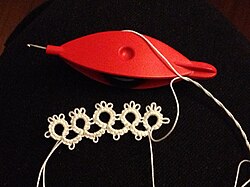I try to post every Monday but you know what they say about the best laid plans.....
This week has been hectic and today is the first time that I have made it to the computer to check and respond to emails and to do my weekly post. Sorry to those of you who have tried to find something new and been disappointed.
What news is there?? Well, I have been talking to one of our ladies, Magda. She has very kindly agreed to give a workshop on the old and dying craft of tatting. She is able to accommodate only 4 students at a tine so place is very limited. There are only 4 places and they will be allocated on a first come first served basis so let me know as soon as possible who will be doing this new technique with Magda. We are going to do this workshop at the next meeting on the 1st June as Magda is under deadline pressures at work and is not sure whether she will be able to make the next one on the 13th July. Kits will be provided so that those ladies who want to learn this craft only need bring themselves and of course the cost which will be in the region of about R85 and will include the shuttle and some cotton.
Below you will find the Wikipedia description of tatting which Google supplied:
Tatting is a technique for handcrafting a particularly durable lace constructed by a series of knots and loops.[1] Tatting can be used to make lace edging as well as doilies, collars, and other decorative pieces. The lace is formed by a pattern of rings and chains formed from a series of cow hitch, or half-hitch knots, called double stitches (ds), over a core thread. Gaps can be left between the stitches to form picots, which are used for practical construction as well as decorative effect.
Tatting dates to the early 19th century. The term for tatting in most European languages is derived from French frivolité, which refers to the purely decorative nature of the textiles produced by this technique. The technique was developed to imitate point lace[2]
In German tatting is called Schiffchenarbeit, which means the work of the little boat, referring to the boat-shaped shuttle, and in Italian tatting is called occhi, which means eyes, referring to the rings which make up the lace.[3]


This is only a piece of the information. Just Google "tatting" and click on the Wikipedia entry so you can read all about this craft. It is very interesting.
Till next time
Keep those fingers busy
Sharon
Lovely, tatting is such an interesting craft, and one that I have been meaning to learn. I hope that you will have heaps of fun on 1st June. I am assuming that the rest of the club ladies are welcome to attend and work on their own projects as always?
ReplyDelete